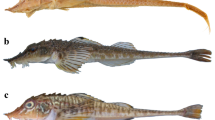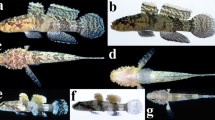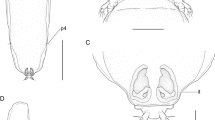Abstract
Asterocheres flustrae n. sp. is described from Flustra foliacea L. (Bryozoa) found in the Kandalaksha Bay of the White Sea. This is the first siphonostomatoid copepod to be reported in association with a bryozoan. Distinctive features of the new species are: (1) a female with 21- and male with 18-segmented antennules; (2) five setae on the inner lobe of the maxillule with one much reduced; (3) an aesthetasc on the syncoxa of the maxilla; (4) a 6-segmented maxilliped with a distal claw; and (5) the armature of endopodal segments 2, 1, 1 and 1. Sexual dimorphism was observed not only on the antennules, but also for maxilliped and legs 1–6. By using SEM some new fine structures were revealed, including: one seta on each of antennulary segments 1 to 4, 6 and 8 with a nipple-like tip and an apical pore surrounded at its base by a circlet of cuticular denticles; a rostral region having a circular area ornamented with minute cuticular protuberances; and the labrum ornamented with fine hair-like setules on either side of its apex.
Similar content being viewed by others
References
Abdelhalim, A.I., Lewis, J.W. & Boxshall, G.A. (1991) The lifecycle of Ergasilus sieboldi Nordmann (Copepoda, Poecilostomatoida), parasitic on British freshwater fish. Journal of Natural History, 25, 559–582.
Anstensrud, M. (1990) Molting and mating in Lepeophtheirus pectoralis (Copepoda, Caligidae). Journal of the Marine Biological Association of the United Kingdom, 70, 269–281.
Benz, G.W., Mohan, P.J. & Crow, G.L. (1992) Developmental stages of Paralebion elongatus from aquarium-held reef whitetip sharks (Triaenodon obesus) captured in Hawaiian waters. Journal of Parasitology, 78, 1,027–1,035.
Boeck, A. (1859) Beskivelse over tvende nye parasitiske Krebsdyr, Artotrogus orbicularis og Asterocheres liljeborgii. Forhandlinger i Videnskabs-Selskabet i Christiania, (1859), 171–182.
Boxshall, G.A. (1990) Siphonostome copepods associated with sponges from Hong Kong. In: Morton, B. (Ed.) The marine flora and fauna of Hong Kong and Southern China Vol. 2. Taxonomy and ecology. Hong Kong: Hong Kong University Press, pp. 523–547.
Boxshall, G.A. & Huys, R.N. (1994) Asterocheres reginae, a new species of parasitic copepod (Siphonostomatoida: Asterocheridae) from a sponge in Belize. Systematic Parasitology, 27, 19–33.
Bresciani, J. (1986) The fine structure of the integument of freeliving and parasitic copepods. A review. Acta Zoologica, 67, 125–145.
Cook, P.L. (1985) Bryozoa from Ghana – a preliminary survey. Annales. Musée Royal de l'Afrique Centrale, Tervunen, Sciences Zoologiques, 238, 1–315.
Cressey, R. & Cressey, H.B. (1979) The parasitic copepods of Indo-Pacific lizard-fishes (Synodontidae). Smithsonian Contributions to Zoology, 296, 1–71.
Eiselt, J. (1965) Revision und Neubeschreibungen weiterer siphonostomer Cyclopoiden (Copepoda, Crust.) aus der Antarktis. Sitzungsberichte der Osterreichischen Akademie der Wissenschaften. Mathematisch – Naturwissenschaftliche Klasse. Abt. I., 174, 151–169.
Felgenhauer, B.E. (1987) Techniques for preparing crustaceans for scanning electron microscopy. Journal of Crustacean Biology, 7, 71–76.
Ferrari, F.D. (1995) Copepodid stages of idgewayia klausruetzlery, a new species of copepod crustacean (Ridgewayiidae: Calanoida) from the barrier reef in Belize, with comments on appendage development. Proceedings of the Biological Society of Washington, 108, 180–200.
Giesbrecht, W. (1899) Die Asterocheriden des Golfes von Neapel und der angrenzenden Meeres-Abschnitte. Fauna und Flora des Golfes von Neapel und der angrenzenden Meeres-Abschnitte, 25, 1–217.
Gostilovskaja, M.G. (1978) [key to bryozoans of the White Sea]. Moscow: Nauka, 248 pp. (In Russian).
Heptner, M.V. (1968) Description and functional morphology of Megapontius pleurospinosus sp.n. from the Pacific with some remarks on the status of the genus Megapontius within the system of families of the Siponostoma (Copepoda: Cyclopoida). Zoologichesky Zhurnal, 47, 1,628–1,638 (In Russian).
Ho, J.-S. (1984) Copepoda associated with sponges, cnidarians, and tunicates of the sea of Japan. Report of the SadoMarine Biological Station Niigata University, 14, 23–61.
Höeg, J.T., Karnick, E.S. & Frölander, A. (1994) Scanning electron microscopy of mouth appendages in six species of barnacles (Crustacea: Cirripedia: Thoracica). Acta Zoologica, 75, 337–357.
Humes, A.G. (1986) Synopsis of copepods associated with asteroid echinoderms, including new species from the Moluccas. Journal of Natural History, 20, 981–1,020.
Humes, A.G. & Gooding, R.V. (1964) Method for studying the external anatomy of copepods. Crustaceana, 6, 238–240.
Huys, R. & Boxshall, G.A. (1991) Copepod evolution. London: The Ray Society, 486 pp.
Ivanenko, V.N. (1997) Redescription of Asterocheres simulans (Copepoda, Siphonostomatoida, Asterocheridae) – a symbiont of Suberites domuncula ficus (Spongia) from the White Sea. Comments on the taxonomy and ecology. Zoologichesky Zhurnal. (in press).
Ivanenko, V.N. & Smurov, A.V. (1995) Morphology and settlement of the first copepodid stage of Scottomyzon gibberum (Copepoda: Siphonostomatoida, Asterocheridae), the symbiont from the White Sea starfish Asterias rubens (Echinodermata, Asteroidea). Zoologichesky Zhurnal, 74, 52–60 (In Russian).
Ivanenko, V.N. & Smurov, A.V. (1996) About finding of bacteria on symbiotic copepod Scottomyzon gibberum Scott (Siphonostomatoida; Asterocheridae) – possible carrier of pathogenic microorganisms. Doklady Akademii Nauk, 346, 573–575 (In Russian).
Kabata, Z. (1974) Two new features in the morphology of Caligidae (Copepoda). Proceedings of The Third International Congress of Parasitology, Munich, 3, 1,635–1,636.
Kabata, Z. (1981) Copepoda (Crustacea) parasitic on fishes: problems and perspectives. Advances in Parasitology, 9, 1–71.
Kritchagin, N. (1873) Otchet o faunisticheskikh issledovaniyakh proizvedennikh v etom godu po porutcheniyu kievskogo obshestva estestvoispitateley na beregakh Tchernogo morya. Zapiski Kievskago Obschestva Estestvoispitatalei, 3, 346–430 (In Ukranian).
Lindberg, W.J. & Stanton, G. (1988) Bryozoan-associated decapod crustaceans – community patterns and a case of cleaning symbiosis between a shrimp and crab. Bulletin of Marine Science, 42, 411–423.
Malt, S. (1991) The copepod inhabitants of sponges and algae from Hong Kong. Bulletin of the British Museum (Natural History), Zoology, 57, 167–183.
Marcus, A. & Por, F. (1960) Die Copepoden einer Probe aus dem Felsbiotop vonYalta (Krimhalbinsel). Travaux du Muséum d'Histoire Naturelle “Gr. Antipa”, 2, 145–163.
McKinney, F.K. & Jackson, J.B.C. (1991) Bryozoan evolution. Chicago: The University of Chicago Press, Ltd., 238 pp.
Medioni, A. & Soyer, J. (1966) Laophonte? drachi n.sp. Copeppode harpacticoide associe su Bryozoaire Schismopora armata (Hincks, 1860). Vie et Milieu, 17, 1,053–1,064.
Medioni, A. & Soyer, J. (1967) Copépodes harpacticoïdes de Banyuls-sur-Mer. 6. Nouvelles formes associées à des Bryozoaires. Vie et Milieu, 18, 317–344.
Morris, P.J., Linsley, R.M.& Cottrell, J.F. (1991) Amiddle devonian symbiotic relationship involving a gastropod, a trepostomatous bryozoan, and an inferred secondary occupant. Lethaia, 24, 55–67.
Murnane, J.P. (1969) Postembryonic development and systematics of siphonostome copepods (Cyclopoida) associated with sponges from the northeastern coast of the United States. Boston University Graduate School Dissertation, 261 pp.
O'Conner, J.P. (1991) Crustacean records from Lough Hyne (Ine), Co. Cork, Ireland: Part V. Bulletin of The Irish Biogeographical Society, 14, 73–83.
Oldewage, W.H. & Van As, J.G. (1989) On the sensory (?) structure between the frontal plates of Caligus O.F. Müller, 1795 (Copepoda, Caligidae). Crustaceana (Leiden), 57(1), 72–78.
Piasecki, W. (1993) Interantennary organ ofAchtheres percarum von Nordmann, 1832 (Copepoda, Siphonostomatoida, Lernaeopodidae) and some other new details of its external morphology. Acta Parasitologica, 38, 36–40.
Piasecki, W. & Mackinnon, B.M. (1993) Changes in structure of the frontal filament in sequential developmental stages of Caligus elongatus Von Nordmann, 1832 (Crustacea, Copepoda, Siphonostomatoida). Canadian Journal of Zoology, 71, 889–895.
Röttger, R. (1969) Ökologie und Postlarvalentwicklung von Scottomyzon gibberum, eines auf Asterias rubens parasitisch lebenden Copepoden (Cyclopoida, Siphonostoma). Marine Biology, 2, 145–202.
Röttger, R. (1971) Auch ein Seestern hat Ungeziefer... Die parasitische Copepode Scottomyzon gibberum und die Reaktionen seines Wirtes Asterias rubens. Mikrokosmos, 1, 15–19.
Schirl, K. (1973) Cyclopoida Siphonostoma (Crustacea) von Banyuls (Frankreich, Pyrénees-Orientales) mit besonderer Berucksichtigung des Gastwirtverhaltnisses. Bijdragen tot de Dierkunde, 43, 64–92.
Scott, T. & Scott, A. (1894) On some new and rare Crustacea from Scotland. Annals and Magazine of Natural History (Ser. 6), 13, 197–249.
Smurov, A.V. & Ivanenko, V.N. (1993) Growth and changes in cuticular structure of adult females of the symbiotic copepod Scottomyzon gibberum Scott, 1894 (Copepoda, Siphonostomatoida, Asterocheridae). Doklady Akademii Nauk, 333, 552–554 (in Russian).
Sowinsky, V. (1884) K faune rakoobraznikh Tchernogo Morya, I. O njekotorykh parazitnykh formach iz gruppy Copepoda. Zapiski Kievskogo Obshchestva Estestvoispitatelei, 7, 225–262 (in Russian).
Stock, J.H. (1966) Cyclopoida siphonostoma from Mauritius (Crustacea, Copepoda). Beaufortia, 13(159), 145–194.
Stock, J.H. (1969) The names of certain cyclopoid copepods associated with invertebrates in the Black Sea. Crustaceana, 17, 220–222.
Stock, J. H. & Humes, A. G. (1995) Copepoda associated with Echinoidea from the West Indies. Studies of the Natural History of the Caribbean Region, 72, 25–46.
Tchesunov, A.V. (1989) Marine commensal nematodes: diversity, ecology, adaptations, phylogenetical speculations. In: Sveshnikov V.A. [Ed.] Symbiosis of marine animals. Moscow, pp. 20–59 (In Russian).
Yeatman, H.C. (1970) Copepods from Chesapeake Bay sponges including Asterocheres jeanyeatmanae n.sp. Transactions of the American Microscopical Society, 89, 27–38.
Author information
Authors and Affiliations
Rights and permissions
About this article
Cite this article
Ivanenko, V., Smurov, A. Asterocheres flustrae n. sp. (Copepoda: Siphonostomatoida: Asterocheridae) associated with Flustra foliacea L. (Bryozoa) from the White Sea. Syst Parasitol 38, 111–130 (1997). https://doi.org/10.1023/A:1005817307084
Issue Date:
DOI: https://doi.org/10.1023/A:1005817307084




